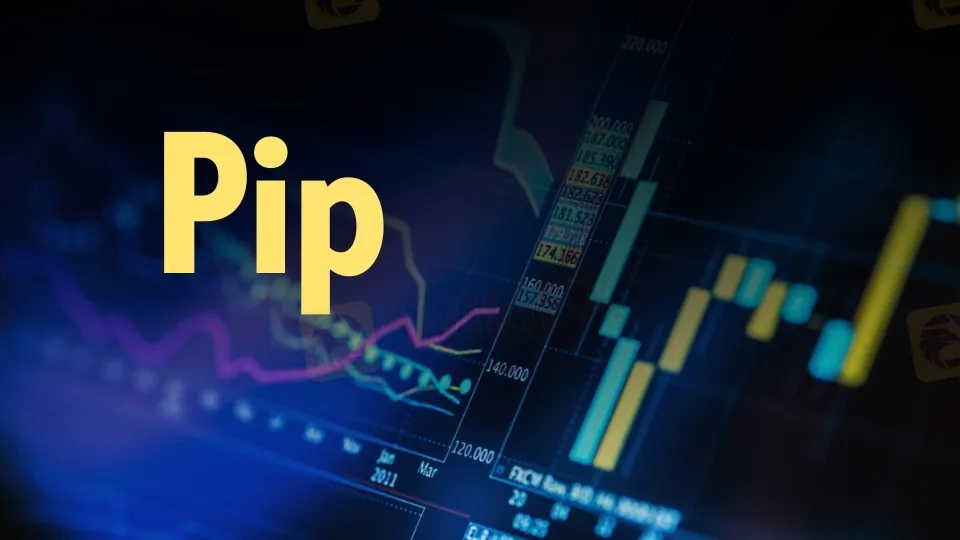Abstract:Learn how much a pip is in forex by lot size: micro (0.01), mini (0.1), standard (1.0). Clear formulas, EUR/USD & USD/JPY examples, and risk management tips.

What Is a Pip in Forex?
- A pip is the standard unit to measure price movement in most forex pairs.
- For most non-JPY pairs quoted to 4 decimals (e.g., EUR/USD 1.1050), 1 pip = 0.0001.
- For JPY pairs quoted to 2 decimals (e.g., USD/JPY 155.30), 1 pip = 0.01.
- Some brokers display a fifth or third “fractional” decimal (pipette); that is 1/10 of a pip and not used in standard pip value math.
Lot Sizes Explained
- Standard lot (1.0) = 100,000 units of the base currency.
- Mini lot (0.10) = 10,000 units.
- Micro lot (0.01) = 1,000 units.
- As the lot size scales up or down, the pip value scales linearly.
Core Formula: How to Calculate Pip Value
For most pairs, when the account currency equals the quote currency (e.g., USD account trading EUR/USD):
Pip value (per lot) = (One pip in decimal) × Contract size. Then convert to the account currency if needed.
- For non-JPY pairs: one pip = 0.0001
- For JPY pairs: one pip = 0.01
- Contract size depends on lot size:
- Standard: 100,000
- Mini: 10,000
- Micro: 1,000
If the account currency differs from the quote currency, multiply the result by the prevailing exchange rate to convert into the account currency.
Pip Value by Lot Size (When Account Currency = Quote Currency)
EUR/USD (USD account)
- Standard lot (1.0): 0.0001 × 100,000 = $10 per pip
- Mini lot (0.10): 0.0001 × 10,000 = $1 per pip
- Micro lot (0.01): 0.0001 × 1,000 = $0.10 per pip
GBP/USD (USD account)
Identical structure to EUR/USD because USD is the quote currency:
- 1.0: $10 per pip
- 0.10: $1 per pip
- 0.01: $0.10 per pip
USD/JPY (USD account)
Here, USD is the base and JPY is the quote. One pip = 0.01 JPY per USD. First, compute the pip value in JPY, then convert to USD:
- Pip value in JPY per standard lot: 0.01 × 100,000 = ¥1,000 per pip
- Convert to USD: ¥1,000 ÷ USD/JPY rate
- Worked example at 155.00:
- Standard lot (1.0): ¥1,000 ÷ 155.00 ≈ $6.45 per pip
- Mini lot (0.10): ¥100 ÷ 155.00 ≈ $0.65 per pip
- Micro lot (0.01): ¥10 ÷ 155.00 ≈ $0.06–$0.07 per pip
Note: These vary with the USD/JPY rate. As USD/JPY rises, each pip (in USD terms) becomes smaller; as it falls, each pip becomes larger.

Quick Reference: 0.01, 0.1, 1.0 Lot Examples
EUR/USD examples (USD account)
- 0.01 lot (micro): $0.10/pip
- 0.10 lot (mini): $1.00/pip
- 1.00 lot (standard): $10.00/pip
$100 move over 100 pips at:
- 0.01 lot: 100 pips × $0.10 = $10
- 0.10 lot: 100 pips × $1.00 = $100
- 1.00 lot: 100 pips × $10.00 = $1,000
USD/JPY examples at 155.00 (USD account)
- 0.01 lot: ≈$0.06–$0.07/pip
- 0.10 lot: ≈$0.65–$0.67/pip
- 1.00 lot: ≈$6.45–$6.67/pip
A 50-pip move at 1.0 lot ≈ 50 × ~$6.45 = ~$322.50
Pips to Dollars Conversion (Step-by-Step)
- Identify if the pair is JPY or non-JPY:
- Non-JPY: pip = 0.0001
- JPY: pip = 0.01
- Multiply by contract size:
- If the quote is USD (e.g., EUR/USD), youre done.
- If the quote is JPY (e.g., USD/JPY), divide pip-value-in-JPY by USD/JPY to get the USD pip value.
- If the quote is EUR and the account is USD (e.g., EUR/GBP), convert using the EUR/USD rate, or more generally, convert the quote-currency pip value into account currency at the prevailing exchange rate.
- 100,000 for 1.0 lot
- 10,000 for 0.10 lot
- 1,000 for 0.01 lot
- If the result is in a non-USD quote and the account is USD, convert at the current rate:
- If the quote is USD (e.g., EUR/USD), youre done.
- If the quote is JPY (e.g., USD/JPY), divide pip-value-in-JPY by USD/JPY to get the USD pip value.
- If the quote is EUR and the account is USD (e.g., EUR/GBP), convert using the EUR/USD rate, or more generally, convert the quote-currency pip value into account currency at the prevailing exchange rate.
How Much Is 1 Pip Worth in USD?
- On pairs with USD as the quote currency (EUR/USD, GBP/USD, AUD/USD, NZD/USD):
- 1.0 lot: $10/pip
- 0.10 lot: $1/pip
- 0.01 lot: $0.10/pip
- On USD/JPY (USD base, JPY quote): ~¥1,000/pip per standard lot, then convert to USD by dividing by USD/JPY.
- On crosses where USD is not the quote currency, compute pip value in the quote currency, then convert to USD.
Pip Value by Currency Pair (Illustrative Guidance)
- EUR/USD, GBP/USD: Most straightforward for USD accounts because USD is the quote currency; pip values are stable and easy to memorize ($10, $1, $0.10).
- USD/JPY: Pip value in USD changes with USD/JPYs level; always reconvert.
- Crosses (e.g., EUR/GBP, EUR/JPY, GBP/JPY): Compute in quote currency first, then convert to the account currency.
How to Calculate Pip Value per Lot (Universal Formula)
- Non-JPY pairs:
- Pip value (quote currency) = 0.0001 × Contract size
- JPY pairs:
- Pip value (quote currency) = 0.01 × Contract size
- If account currency ≠ quote currency:
- Pip value (account currency) = Pip value (quote) × Quote→Account exchange rate
Examples:
- EUR/USD, 0.10 lot: 0.0001 × 10,000 = $1 per pip
- USD/JPY, 1.00 lot at 155.00: (0.01 × 100,000) ÷ 155.00 ≈ $6.45 per pip
- EUR/GBP, 1.00 lot with USD account:
- Pip value in GBP = 0.0001 × 100,000 = £10/pip
- Convert £10 to USD using GBP/USD (e.g., ×1.2850) = ~$12.85/pip
Pip Value Calculator (EUR/USD, USD/JPY)
Traders often use broker-provided or third-party pip value calculators. To use them effectively:
- Select the pair (e.g., EUR/USD, USD/JPY).
- Input lot size (0.01, 0.10, 1.00).
- Choose account currency (e.g., USD).
- The tool returns pip value, auto-converting when necessary (especially for JPY and cross pairs).
Pips per Lot and Risk Management
Pip value directly links to risk, because dollar risk = pip value × stop distance × number of lots.
Risk per trade (in dollars) = Pip value × Stop-loss (pips) × Lots
Practical approach:
- Define the dollar amount willing to risk per trade (e.g., 1% of equity).
- Determine the technical stop in pips.
- Solve for lot size:
- Lot size = Risk / (Pip value per 1.0 lot × Stop distance)
- Alternatively, first compute $/pip target = Risk ÷ Stop distance, then match to a lot size.
Example (EUR/USD, USD account):
- Account: $5,000
- Risk: 1% = $50
- Stop: 25 pips
- Target $/pip = $50/25 = $2 per pip
- Closest size: 0.20 lots (because at 0.10 lots it‘s $1/pip; at 0.20 lots it’s ~$2/pip)
Example (USD/JPY at 155.00, USD account):
- Risk: $75
- Stop: 30 pips
- Pip value per standard lot: ≈$6.45
- $/pip target = $75/30 = $2.50
- Lot size ≈ $2.50 ÷ $6.45 ≈ 0.39 lots
Risk guidelines:
- Keep single-trade risk small (commonly 0.5%–2% of equity).
- Adjust lot size when volatility changes (ATR rises → reduce size).
- Recheck pip value when trading JPY pairs or crosses, as conversion changes with price.
Frequently Asked Questions
Is pip value always $10, $1, $0.10 for 1.0, 0.10, 0.01?
- Only when the account currency matches the quote currency and the pair is non-JPY with 4 decimals (e.g., EUR/USD on a USD account).
- JPY pairs and non-USD quote currencies require conversion.
What about pairs quoted to 5 or 3 decimals?
- Those extra decimals are pipettes (tenths of a pip). The pip definition itself doesnt change.
Do CFDs on indices/commodities use pips?
- Many use “points” or “ticks,” with different contract specifications. Always check the instruments spec rather than assuming pip math.
What if a broker shows different contract sizes?
- Always confirm contract specifications in the platform (symbol information). Most FX brokers use the 100,000/10,000/1,000 standard, but exceptions exist.
Stay tuned for more educational articles. Scan the QR code below to download and install the WikiFX app on your smartphone.











